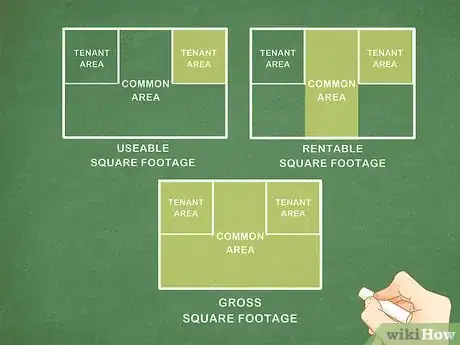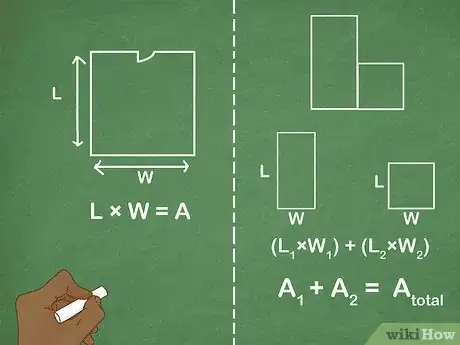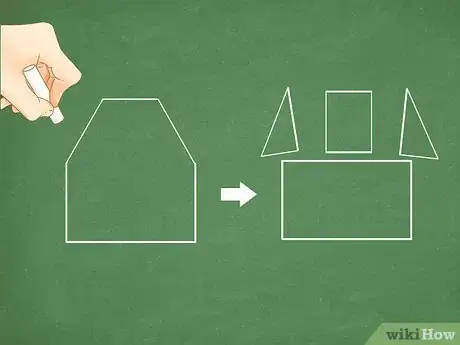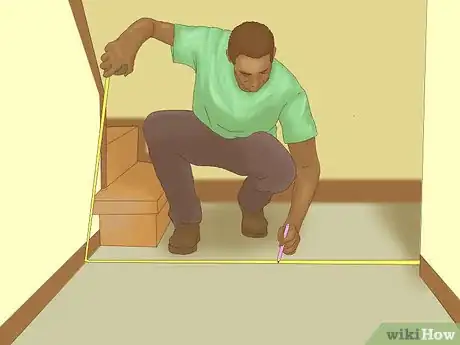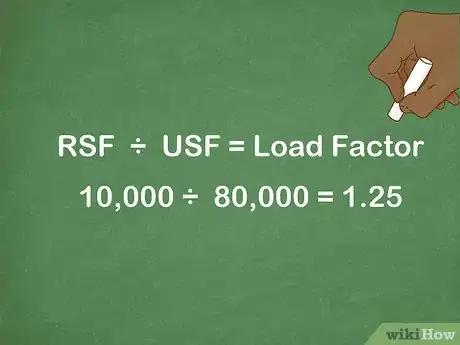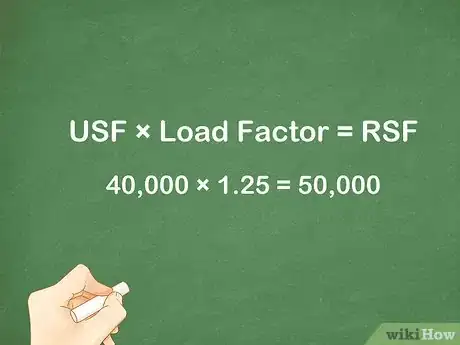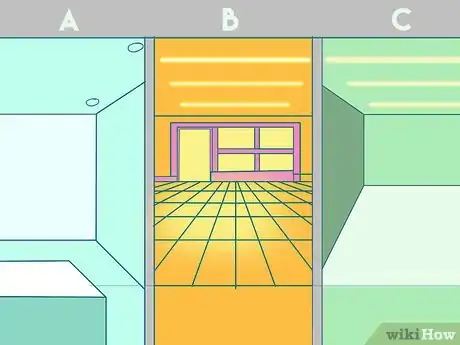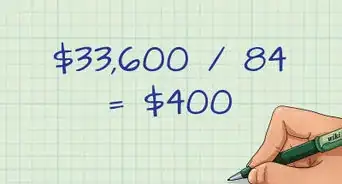This article was co-authored by Carla Toebe. Carla Toebe is a licensed Real Estate Broker in Richland, Washington. She has been an active real estate broker since 2005, and founded the real estate agency CT Realty LLC in 2013. She graduated from Washington State University with a BA in Business Administration and Management Information Systems.
wikiHow marks an article as reader-approved once it receives enough positive feedback. In this case, 82% of readers who voted found the article helpful, earning it our reader-approved status.
This article has been viewed 190,101 times.
Calculating the square footage of commercial space is a complicated process that requires relentless attention to detail. Renters must consider an array of factors when deciding whether to enter a lease arrangement, including overall square footage of the building and regional standards. Tenants who fail to grasp important concepts are sometimes surprised by hidden costs and useable spaces that are smaller than they had envisioned.
Steps
Choosing a Measurement Method
-
1Compare measurement techniques. Landlords may use several different measurement techniques to assess the square footage of a space. These methods include:
- Useable square footage, or USF: This is the space the tenant actually occupies. Rental agents often quote this figure to prospective renters, but it represents only part of the lease arrangement.
- Rentable square footage, or RSF: This is the combination of the useable square footage and a percentage of the common-area square footage of the building. Common areas, which are parts of a building all tenants benefit from, include the lobby, elevators, hallways and stairwells.
- Gross square footage, or GSF: The entire rentable square footage of a building.
-
2Decide what method of calculating commercial space is best for you. The Building Owners and Managers Association (BOMA) simplified industry standards for measuring rentable space in commercial buildings in 2010. The BOMA's 2 leading methods are Method B and Legacy Method A.
- Method B: The new Single Load Factor Method calculates the rentable space for each tenant using a uniform approach in measuring floor area. It is the same for all floor levels of a building.
- Legacy Method A: The 1996 standard uses separate unit prices for the USF and common square footage. In some cases, it may be beneficial for tenants to opt for this approach.[1]
Advertisement -
3Choose a measurement method based on the property type. Typically, the measurement technique used will depend on the intended usage of the property and the planned number of tenants. Office buildings, shopping centers, and other multi-tenant buildings will typically be measured using RSF. Single-tenant buildings like warehouses or production facilities are measured using GSF. However, landlords may not be required to use a specific method to measure a space.
-
4Consider regional leasing standards. Federal law allows landlords to measure rentable space using any method they desire. However, certain parts of the country may have different rules for calculating square footage. Two notable examples are:
- The Real Estate Board of New York (REBNY) allows building owners to maximize profits by letting them bring RSF as close as possible to GSF.
- Tropical areas: New rules account for enclosed and open areas of commercial buildings in areas normally affected by specific weather conditions.
Measuring Commercial Square Footage
-
1Take nothing for granted. Measure the useable space yourself. A miscalculation in determining square footage can cost you thousands of dollars over the duration of the lease. Typical measurement standards allow for a 2 percent error tolerance when measuring commercial space. However, this can translate to a lot of money, especially in large or expensive spaces. Make sure to measure the area as carefully as possible, especially if you are the tenant that might be negatively affected by these miscalculations.
-
2Measure simple square footage. To measure commercial square footage for a rectangular space, multiply the length of the room in feet by its width. For example, a room that is 12 feet long by 12 feet wide is 144 square feet. For L-shaped or divided spaces, you can measure rectangles of space independently and then sum the areas to get a total area measurement.
- Measurements may be taken using a tape measure or laser measuring device.
-
3Account for unusual shapes. Take care when measuring irregularly-shaped sections of a room. To conduct your measurement, try splitting the room into shapes with easy-to-calculate areas, such as rectangles and triangles. The area of a right triangle can be found by multiplying the lengths of the two non-diagonal sides (those two joined by the right angle) and then dividing the product by 2.
- For example, if there is a room with a diagonal wall running through it, you must use a more-complicated formula to determine the area's square footage. If the length of the space with the diagonal wall was 10 feet and its width was 8 feet, the square footage of the area would be 40 feet.
- That is because the wall cuts the total square footage, which would have been 80 if the room had no wall intersecting it, in half.[2]
-
4Measure common areas. Common areas should be measured so that rentable square feet can be calculated. Common area square footage is measured using the same methods as usable square footage unless otherwise provided for in local laws. Common areas might include elevators, bathrooms, lobbies, stairwells, and hallways. Importantly, common areas must be available to all tenants to use or benefit from. Make sure to measure the total square footage of all common areas in the building.[3]
-
5Finding gross square footage. Gross square footage measures the total area of the space, including the thickness of exterior walls. To measure this area, you will need to measure wall length from the outside of the building and use those dimensions to calculate square footage. GSF is not reduced for obstructions such as ventilation shafts, support beams, or elevator shafts. GSF does not include open areas such as parking lots, pools, or unexcavated basement areas.[4]
Using Square Footage Information
-
1Calculate load factor for the building. The load factor represents the additional percentage of square footage added to usable square footage to calculate rentable square footage. To calculate load factor, start by finding the total usable and rentable square footages of the building in questions. Remember that the usable square footage is the area that can be rented to tenants and the rentable square footage is that area plus common areas. Then, divide RSF by USF to get the load factor.[5]
- For example, if a building has 80,000 square feet of usable space and an additional 20,000 square feet of common areas, the rentable square footage would be 100,000.
- Then, the load factor would be calculated as 100,000 / 80,000 = 1.25.
-
2Finding rentable square footage for a property. The rentable square footage for a property can be calculated using the building's load factor and USF of the property. The load factor is multiplied by the USF to get the RSF. You can then use the RSF and price per square foot to figure out the monthly rent.[6]
- Continuing with the previous example, imagine that the property is divided in half between two commercial spaces. So, each one has 40,000 square feet of usable space.
- To find RSF, multiply this amount by the load factor, which is 1.25. This means that the RSF in this case would be 40,000 x 1.25 = 50,000.
-
3Weigh the differences in commercial properties. Unit prices can vary widely based on the location and class of the building. The rent on a 500 square foot (46.5 square m) office downtown might run higher than the rent on a 1,000 square foot space (92.9 square m) only 10 blocks away. Buildings fall into 1 of 3 standard classifications.
- Class A: These are the most prestigious buildings in the most-exclusive sections of a city. Class A buildings command higher rents than average.
- Class B: This is the broadest classification. Most of these buildings have fair to good finishes.
- Class C: Units in this class are highly functional but offer few amenities. Rents are generally low.[7]
-
4Calculate total rent for a property based on square footage. Rents are typically based on a space's RSF or GSF. Once you have this data, you can use the market price per square foot to determine a rent price for the property. Continuing with the example above, if rent were $1.50 per square foot of RSF per month, the rent would be $1.50 x 50,000 = $75,000.[8]
Expert Q&A
Did you know you can get expert answers for this article?
Unlock expert answers by supporting wikiHow
-
QuestionIs square footage rounded to the nearest foot?
 Carla ToebeCarla Toebe is a licensed Real Estate Broker in Richland, Washington. She has been an active real estate broker since 2005, and founded the real estate agency CT Realty LLC in 2013. She graduated from Washington State University with a BA in Business Administration and Management Information Systems.
Carla ToebeCarla Toebe is a licensed Real Estate Broker in Richland, Washington. She has been an active real estate broker since 2005, and founded the real estate agency CT Realty LLC in 2013. She graduated from Washington State University with a BA in Business Administration and Management Information Systems.
Real Estate Broker
References
- ↑ https://www.thebalance.com/calculating-commercial-rents-3515436
- ↑ http://nemesis.lonestar.org/reference/measures/nonsquare.html
- ↑ https://www.thebalance.com/calculating-commercial-rents-3515436
- ↑ https://nces.ed.gov/pubs2006/ficm/content.asp?ContentType=Section&chapter=3§ion=2&subsection=1
- ↑ http://www.propertymetrics.com/blog/2013/12/19/rentable-square-feet/
- ↑ http://www.propertymetrics.com/blog/2013/12/19/rentable-square-feet/
- ↑ http://www.propertymetrics.com/blog/2013/02/27/types-of-commercial-real-estate/
- ↑ https://www.thebalance.com/calculating-commercial-rents-3515436
About This Article
To measure commercial square footage for your commercial property, you can use several different methods. Useable square footage only covers the space occupied by the tenant. Rentable square footage combines the useable square footage with a percentage of the common areas’ square footage. Alternatively, gross square footage covers the entire square footage of the building, which you calculate by measuring the exterior walls. To measure rectangular rooms, simply multiply the length by the width. For example, if a room is 12 feet by 12 feet, it would be 144 square feet. For L-shaped or divided rooms, split them into multiple shapes and calculate their square footage independently. Then, add them together to give you the room’s total square footage. For more tips from our Real Estate co-author, including how to calculate total rent based on a property’s square footage, read on!
